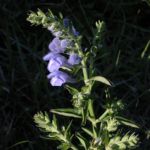| Common Name: |
Mad Dog Skullcap |
| Other Names: |
Virginia Skullcap |
| Botanical Name: |
Scutellaria lateriflora |
| Genus: |
Scutellaria |
| Family: |
Lamiaceae |
| Native Location: |
Native to N America, especially north and west |
| Cultivation: |
Light, well-drained soil in sun or partial shade. Scutellaria lateriflora enjoys damp conditions. Scutellaria baicalensis need sharp drainage and tolerates drough. Cut back to within 7-10cm (3-4in) of the base in early spring and pinch out in spring to encourage bushy growth. |
| Propagation: |
By seed sown in autumn; by division in autumn or spring; by basal or semi-ripe cuttings in spring or summer. |
| Harvest: |
ROots (S. baicalensis) are lifted in autumn or spring from plants 3-4 year old, and dried for decoctions. Plants (S. lateriflora) are cut when flowering for use in infusions, liquid extract, and tinctures, or dried for tablets. |
| Height: |
15-75cm (6-30in) |
| Width: |
45cm (18in) |
| Hardiness: |
Z3-8 |
| Parts Used: |
Whole Plant |
| Chemical Constituents: |
Cellulose
Fat
Scutellarin
Sugar
Tannins
|
| Properties: |
A bitter, sedative herb that relaxes spasms, lowers fever, and stimulates the kidnes. |
| Known Effects: |
Increases stomach acidity
Irritates mucous membranes
Relieves spasm in skeletal or smooth muscle
Interferes with the absorption of iron and other minerals when taken internally
|
| Possible Additional Effects: |
May stimulate appetite
May relieve intestinal cramps
|
| Medicinal Uses: |
Internally for nervous and convulsive complaints, insomnia, tension headaches, nervous exhaustion, irritability, delerium tremens, neuralgia, and withdrawal from barbiturates and tranquilizers. |
| Warnings and Precautions: |
Excess causes giddiness, stupor, confusion, and twitching.
Contraindicated during pregnancy.
Don't take if you:
Are pregnant, think you are pregnant, or plan pregnancy in the near future.
Consult your doctor if you:
Take this herb for any medical problem that doesn't improve in 2 weeks (There may be safer, more effective treatments.)
Take any medicinal drugs or herbs including aspirins, laxatives, cold and cough remedies, antacids, vitamins, minerals, amino acids, supplements, other prescription or non-prescription drugs
Pregnancy:
Don't use unless prescribed by your doctor.
Breastfeeding:
Don't use unless prescribed by your doctor.
Infants and Children:
Treating infants and children under 2 with any herbal preparation is hazardous.
Others:
None are expected if you are beyond childhood, not pregnant, under 45, basically healthy, take it only for a short time and do not exceed manufacturer's recommended dose.
Storage:
Store in cool, dry area away from direct light. Don't freeze.
Store safely out of reach of children.
Do not store in bathroom medicine cabinet. Heat and moisture may change the action of the herb.
Safe Dosage:
Consult your doctor for the appropriate dose for your condition.
|
| Toxicity: |
Rated relatively safe when taken in appropriate quantities for short periods of time. |
| Adverse Reactions, Side Effects, or Overdose Symptoms: |
| Signs and Symptoms |
What to do |
|
| Confusion |
Discontinue. Call doctor immediately. |
| Giddiness |
Discontinue. Call doctor when convenient. |
| Irregular Heartbeat |
Seek emergency treatment |
| Stupor |
Seek emergency treatment |
|
| Bibliography: |
Encyclopedia of Herbs by Deni Brown Copyright © 1995, 2001 Dorling Kindersley Limited Pp 364-365
Vitamins, Herbs, Minerals, & Supplements The Complete Guide by H. Winter Griffith, MD Copyright©1998 Fisher Books pp. 456-457 |

